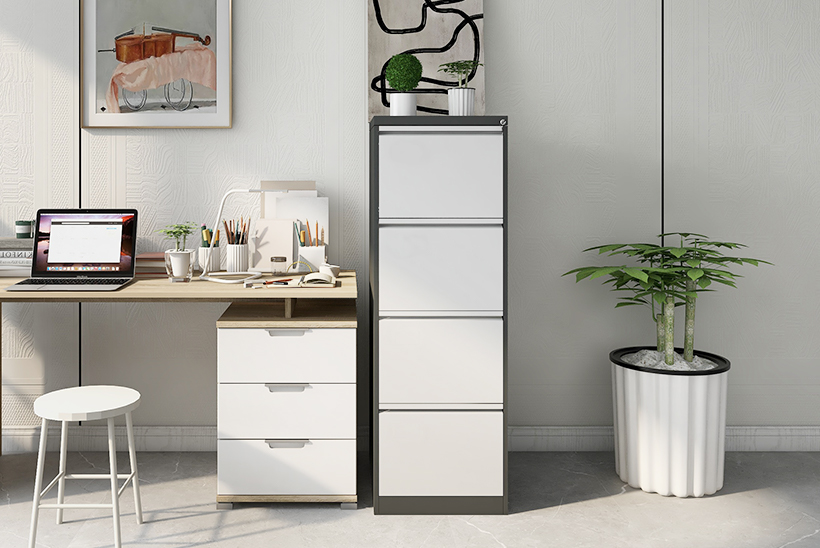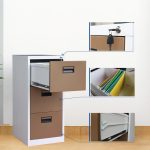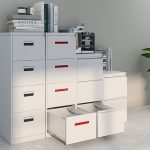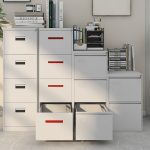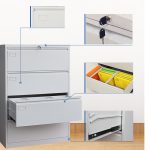Tired of staring at that old drawer filing cabinet gathering dust? Give it a new lease on life by converting it into a sustainable, space-saving garden bed! This project blends eco-friendly creativity with practical gardening, perfect for urban dwellers or anyone craving a touch of green. Here’s how to turn metal drawers into a thriving oasis.
Materials & Tools You’ll Need您需要的材料和工具
Materials: 材料 :
- Old filing cabinet (2-4 drawers ideal)
- Exterior-grade spray paint or rust-resistant paint
- Clear waterproof sealant (e.g., polyurethane)
- Landscape fabric or mesh
- Potting soil, compost, and perlite (for drainage)
- Gravel or small rocks (optional)
Tools:
- Drill with ½” metal drill bit
- Screwdriver (to remove drawers and hardware)
- Sandpaper (120–220 grit)
- Staple gun or heavy-duty glue
- Gardening gloves and safety goggles
A Step-by-Step Guide
Step 1: Prep Your Filing Cabinet
Clean & Sanitize:
Remove drawers and hardware. Scrub the cabinet inside and out with a mix of warm water, vinegar, and dish soap. Rinse and let dry. Sand away rust or rough edges, then wipe clean.
Modify the Structure:
Remove locking mechanisms or sharp internal parts. Decide if you’ll use drawers as tiered planters or keep them closed. For a raised bed, remove drawers entirely and use the cabinet frame.
Step 2: Create Drainage (Essential!)
Drill Drainage Holes: Drill 8–10 holes (½” diameter) in the bottom of each drawer or the cabinet base. Space holes 6” apart.
Pro Tip: Angle holes slightly to prevent soil clogging.
Line with Landscape Fabric: Cut fabric to fit inside drawers or the cabinet. Secure with staples or glue. This keeps soil in while allowing water to drain.
Step 3: Paint & Weatherproof
Prime and Paint: Spray paint the exterior with rust-resistant paint. Opt for bold colors (teal, sunflower yellow) or earthy tones to match your garden aesthetic. Let dry completely between coats.
Seal for Longevity: Apply 2–3 coats of waterproof sealant, focusing on edges and corners. This protects against rain and humidity.
Step 4: Fill with Soil
Layer for Success: Add a 1–2” layer of gravel to the bottom (optional for extra drainage). Mix potting soil, compost, and perlite (2:1:1 ratio) for nutrient-rich, well-draining soil. Fill drawers or the cabinet ¾ full.
Boost Nutrients: Mix in slow-release fertilizer pellets or worm castings for a thriving plant ecosystem.
Step 5: Plant Your Garden Bed
Best Plants for Filing Cabinet Gardens:
Herbs: Basil, thyme, mint (shallow roots, love containers).
Vegetables: Lettuce, radishes, dwarf carrots (if cabinet is deep enough).
Flowers: Marigolds, petunias, succulents (colorful and low-maintenance).
Planting Tips: Arrange taller plants (like rosemary) at the back, trailing varieties (ivy) near edges.Leave 3–4” between plants to avoid overcrowding.
Step 6: Maintain Your Upcycled Garden
Water Wisely: Container gardens dry out faster. Water when the top 1” of soil feels dry. Use a watering can with a narrow spout to target roots.
Fertilize Monthly: Feed plants with liquid seaweed or compost tea every 4–6 weeks.
Pest Control: Spray neem oil weekly to deter aphids and mites. Add marigolds to repel pests naturally.
Seasonal Care: In winter, move the cabinet to a sheltered spot or cover with burlap. Refresh soil each spring by mixing in compost.
Creative Upgrades to Try
Tiered Herb Garden: Keep drawers partially open at varying levels for a cascading effect.
Mobility: Add casters to the cabinet base for easy repositioning.
Labels: Use chalkboard paint on the cabinet sides to note plant names.
Why You’ll Love This Project
Eco-Friendly: Diverts metal from landfills.
Space-Smart: Perfect for patios, balconies, or small yards.
Conversation Starter: Combines industrial charm with lush greenery.
FAQ:
What else can I DIY to transform the drawer filing cabinet into?
Old drawer filing cabinets can be transformed into bookshelves, storage cabinets, display cabinets, TV cabinets, children's toy storage boxes, personalized workbenches and even pet nests, which are very useful.
Can any filing cabinet be used for this project?
Most metal drawer filing cabinets work well, but avoid ones with severe rust or structural damage. Wooden cabinets may rot over time. For best results, choose a cabinet with 2-4 drawers to create depth for plant roots.
Do I need to remove rust from the filing cabinet first?
Yes! Sand off rust spots with medium-grit sandpaper and treat the area with a rust converter or primer. This prevents further corrosion and ensures a smooth surface for painting.
Will the drawer cabinet overheat plants in summer?
Metal can retain heat. To prevent root damage: Place the cabinet in partial shade during peak sun; Use light-colored paint to reflect heat; Add mulch on top of the soil to insulate roots.
Can I line the cabinet with plastic instead of landscape fabric?
Yes, but poke drainage holes in the plastic to avoid waterlogging. Landscape fabric is more breathable and eco-friendly, but heavy-duty plastic (like a pond liner) works for extra moisture protection.
Is it safe to grow edible plants in a drawer filing cabinet?
Modern filing cabinets are typically coated with non-toxic paints. To be safe: Use a liner (landscape fabric or food-safe plastic) between the metal and soil. Avoid growing root vegetables if concerned about metal leaching.
Final Thought:
Don’t let that filing cabinet rust away! With a few hours and creativity, you can cultivate a garden that’s as unique as your DIY spirit.
Safety First: Always wear gloves and goggles when drilling or handling metal edges!


